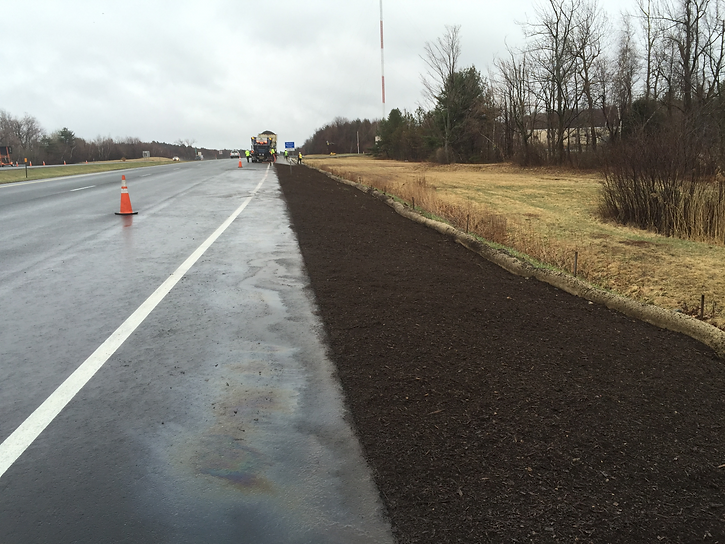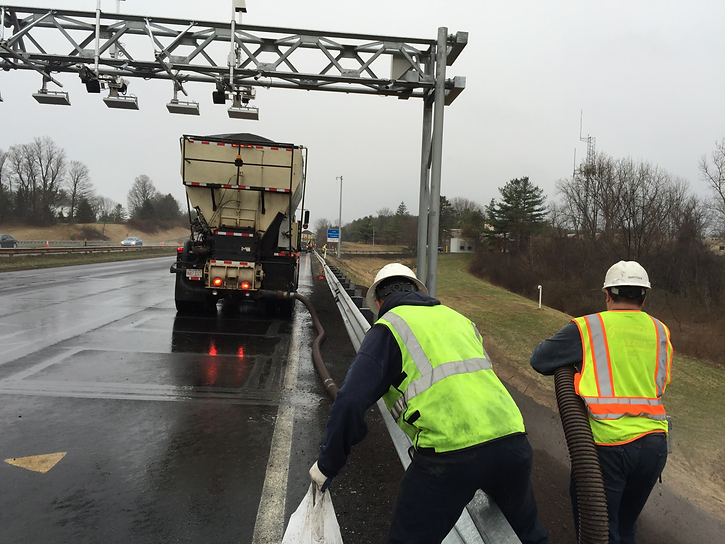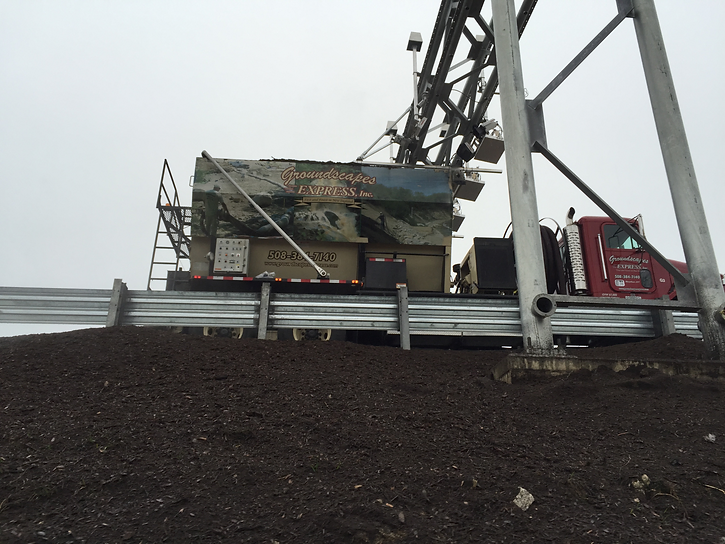These are photos of our soil building, stabilization, and vegetation establishment project that ran from New York State to Boston MA. The toll booths are being replaced by an electronic pass – reader. Once the toll booths were removed and the ground where they were located had been roughly graded we were tasked with establishing vegetation on those areas. The tradition way that that was to be done is by fine grading the area, then hydro-seeding in grass seed as a ground cover. The State Department of Transportation and Raytheon Corporation the firm that has the contract to remove the existing tolls and repair along with Groundscapes Express, Inc. of Wrentham, M.A. have partnered in testing out alternative methods to just hydro-seeding and establishing lawn / turf grasses in these disturbed areas. Groundscapes Express, Inc. has had an ongoing relationship with the department for many years now. They have both been working together to try and develop novel methods and practices in creating roadways that improve the overall look, feel, and management in a way that is more sustainable and regenerative. The goal of this project is to establish long-term vegetation. When turf grasses are established they require intensive management for their establishment and maintenance in order to sustain them. They require adequate moisture in the form of precipitation, rainfall or snowmelt, petroleum salt – based fertilizers are customarily used for seed establishment, but probably one of the most energy intensive practice is the importation of “top-soil”, which is to be placed upon the graded and compacted sub-soils to act as a seed bed for the establishment of grass seed. This activity requires the use of very heavy equipment to extract the top most layer of soil from either an area that is going to be newly developed for a parking lot, roadway, building complex, or for any purpose for new construction, once the site has been denuded of its existing vegetation, or if the “top-soil” has been stock-piled and stored on an offsite location after it has been removed. Before, I go on let me say that the term “top – soil” has not be clarified or characterized as any material that has a dark “humusy”, organic mix and is free of rocks, large particles of woody debris, so that it can provide a uniform surface to place the seed upon. This material may contain weed seeds or propagules, and those vegetative materials may have come from exotic invasive plants. Really none of this contributes to seed establishment or vegetative longevity, nor does it relate to future management considerations. The sheer number of “trips” that are necessary to extract, load and transport these materials creates excessive environmental costs, energy costs, and costs to public safety. For every load of topsoil that is transported there has to be a detail police officer controlling traffic to enable these trucks to exit the highway and enter the highway once they have off – loaded their tare, which will occur during peak and off – peak traffic times. Inevitably this causes “rubber – necking” and today with the likelihood of cell phone use while driving only increases the possibility of even more emergent traffic incidents! The use of heavy equipment to move the materials around so that they can be placed to the location on site where they then need another piece of equipment to spread this material, and many times need another machine to smooth out the rough spots. These practices incur a tremendous cost of energy and carbon pollution, and soil compaction, which is contrary for seed establishment. Groundscapes Express, Inc. employs an entirely new – line of landscape practices for soil erosion and sediment pollution for storm-water management. We use a biologically active compost-based approach, which is based on the use of compost as a soil treatment. Biologically active compost is home to a complex population of micro-organisms. This approach is based on soil health rather than pathology, and on soil and plant ecology rather than on chemistry. Soil fertility is dependent upon the biological life of the soil and not simply its basic chemical composition. The health of the soil depends on maintaining its biological balance. The species that make up this microbiological world of the soil perform a series of essential services to plants. They locate and deliver nutrients. They process nutrients, transforming them from inaccessible forms into forms that can be ingested and used by plants. They consume pests and parasites that live in the soil and attack plant roots. They aggregate the soil and make it so rainwater can enter and waste gasses can escape. Commercial chemistry’s response to soil fertility is criticized as overly simplistic and as tending to exacerbate soil deficiencies. The chemists worked out the mineral requirements of plants and most ably provided us with these minerals in soluble form. that application of nitrogen and phosphorus-based fertilizers might alter or impair soil composition and/or functioning in ways that would be injurious to plants. If it is the life of the soil that is its most important property, then obviously we must stop killing it with lethal chemical salts. The danger posed by artificial fertilizers is that they depress the biological functioning of the soil and, thus, restrict the nutrients available to plants and/or restrict access to the protection from disease offered by organisms in the soil. Also, application of artificial fertilizers leads to faster plant growth, yet this rapid fertilizer-induced growth creates weaker plants, and this weakness transfers to poor landscape quality, and declining conditions as the landscape matures. Instead of relying on artificial fertilizers for quick growth and then ‘chemical sprays’ to tackle the diseases that take hold in the now-weakened plantings, land manager’s should focus on maintaining and improving the functioning of the soil, in particular, the top, humus layer, which contains the greatest amount of organic matter! Unless a soil is teaming with micro-organisms, including mycorrhizal fungi species, plants growing in it will not be able to gain access to the full range of minerals, vitamins and other nutrients they require in order to be healthy and resist disease. If plants are not healthy and resistant to disease, and have their origin in a fertile soil … a fertile soil is an alive soil. A healthy soil will support water’s natural movement and flow in ways that help us, rather than hurt us? Landscapes regenerating with the care and maintenance of two things: soil and water will support a diverse array of flora and fauna across the state. The water cycle affects which plants are suited to the environment, and the ecological impact of plants and macro and micro – organisms helps determine the hydrology of a landscape. The land management practices used by Groundscapes Express, Inc. directly impacts upon the landscape’s ability to absorb water and how water is used directly impacts the health of soil and therefore, the health of the entire “living landscape”.







